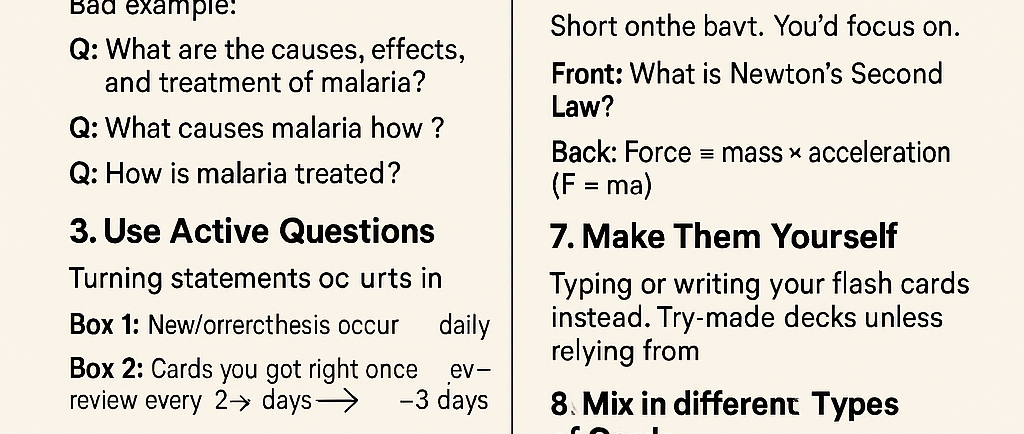How to Make Flash Cards for Smart Revision: A Complete Guide


Flash cards are one of the most effective tools for active recall — a proven technique to boost memory and retention. Whether you’re studying for school exams, competitive tests, or learning a new language, using flash cards the smart way can cut down your revision time and dramatically improve your results. Here’s how to make them effectively for smart revision.
⸻
1. Start with Clear Goals
Before making your flash cards, ask:
• What subject/topic am I revising?
• What are the key concepts or facts I must remember?
Having a focused topic ensures your cards are relevant and not cluttered with unnecessary information.
⸻
2. Stick to One Question Per Card
Each card should focus on one piece of information. This helps your brain associate a single cue with a single answer, which is ideal for fast recall.
Bad example:
Q: What are the causes, effects, and treatment of malaria?
(This is too broad.)
Good example:
Q: What causes malaria?
Q: What are the symptoms of malaria?
Q: How is malaria treated?
⸻
3. Use Active Questions
Turn notes into questions wherever possible. The goal is to trigger your memory, not passively review.
Instead of: “Photosynthesis occurs in the chloroplasts.”
Use: “Where does photosynthesis occur?”
⸻
4. Include Visuals Where Useful
A diagram, chart, or even a simple sketch can help explain a concept faster and more effectively than words. Use them especially for subjects like biology, geography, or physics.
⸻
5. Use the Leitner System for Smart Spaced Repetition
This is the secret behind smart revision. It works like this:
• Box 1: New/incorrect cards — review daily.
• Box 2: Cards you got right once — review every 2-3 days.
• Box 3: Cards you consistently get right — review weekly.
Keep moving cards between boxes based on performance. Apps like Anki automate this beautifully.
⸻
6. Avoid Overloading the Cards
Keep the back of the card short and punchy. Your goal is to jog your memory, not write a mini-essay.
Example:
• Front: What is Newton’s Second Law?
• Back: Force = mass × acceleration (F = ma)
⸻
7. Make Them Yourself
Typing or writing your own flash cards forces you to process the information better. Don’t rely on pre-made decks unless you review them actively and customize them.
⸻
8. Mix in Different Types of Cards
Use a combination of:
• Definition cards: “Define osmosis.”
• Concept cards: “Why is osmosis important in plants?”
• Image-based cards: Label parts of a diagram.
• Application cards: “How is osmosis used in food preservation?”
This keeps your brain engaged and boosts long-term memory.
⸻
9. Review Regularly, Not Cram
Smart revision is all about timing. Review your cards daily for short periods (10–20 minutes), and increase the interval between sessions as you improve.
⸻
10. Use Digital Tools for Convenience
If you’re short on time or prefer studying on-the-go, apps like:
• Anki (custom spaced repetition)
• Quizlet (user-friendly and great for visuals)
• Brainscape (confidence-based spacing)
They can save your progress, sync across devices, and remind you when it’s time to review.
⸻
Final Thoughts:
Making flash cards is not just about copying notes — it’s about training your brain to retrieve and apply knowledge efficiently. When done right, they’re a powerhouse of smart revision.
